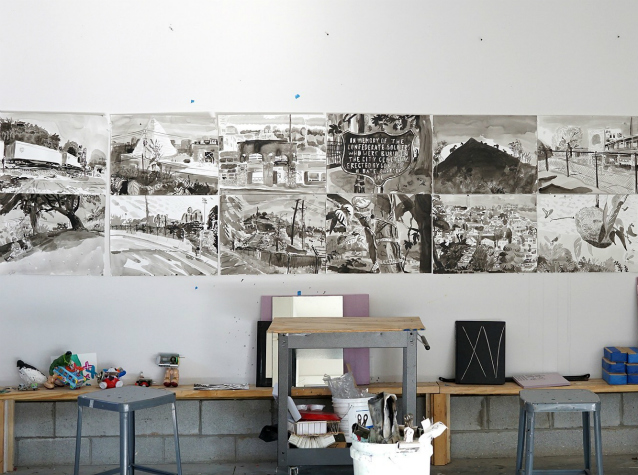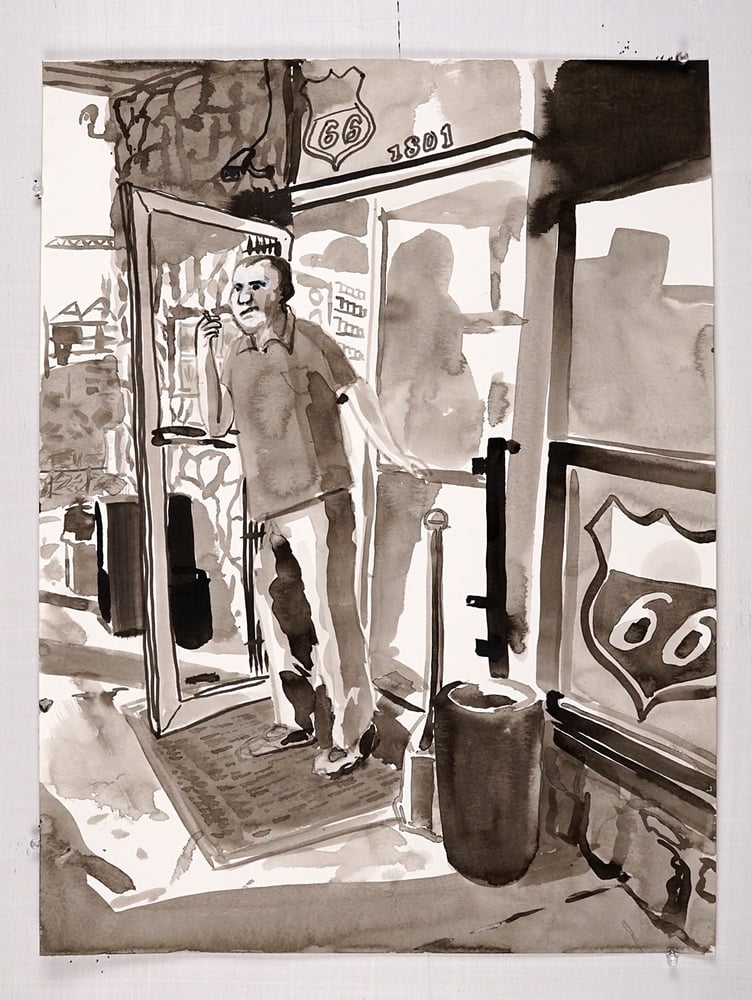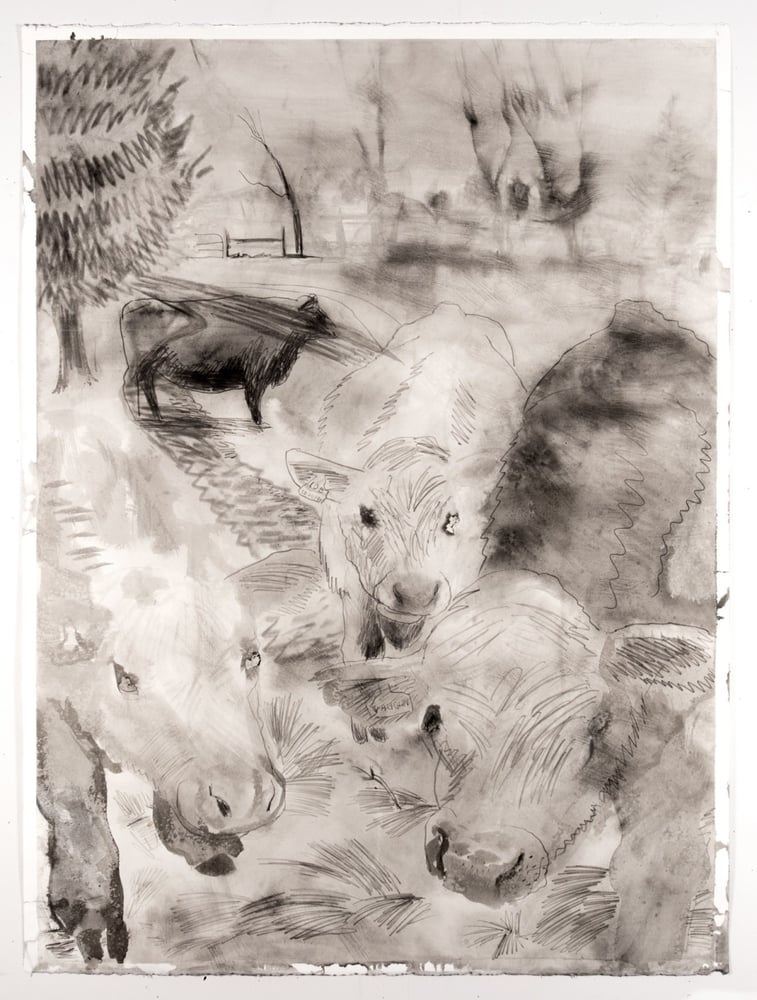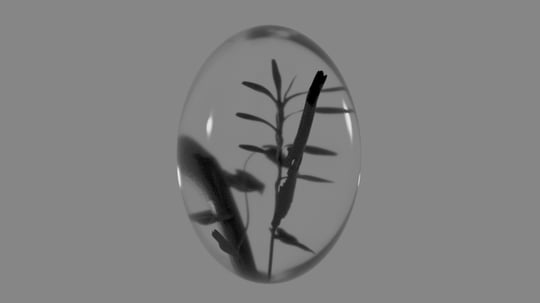
After stints in New York and Colorado, artists Paul Collins and Alex Blau relocated with their family to Nashville in 2011 when Collins accepted a teaching position at Austin Peay State University. Described by Collins as “collaborative and non-hierarchical,” the city’s growing art community is what keeps them in Nashville, where they’re both represented by Zeitgeist Gallery. In Blau’s most recent solo exhibition, last fall’s “Night Swimming” at Zeitgeist, effusive swaths of dye and airbrush paint signaled a transition from her previous hard-lined style.
On view at Zeitgeist through March 31, Collins’s exhibition “Fortnight Sessions” marks another sort of departure for the artist: in this case, from the studio. Comprising over 100 drawings in total, the entire body of work in “Fortnight Sessions” was created at public sites in Nashville, rural Tennessee, and Rome, Italy. When I visited the building in the couple’s backyard where their studios are located, Collins described the project while we waited for Blau to return from a class she was teaching at Vanderbilt.
Logan Lockner: Do each of these series represent one day, or are you spending a fortnight on each project?
Paul Collins: Fourteen days! It started out very straightforward—a drawing or two a day at one location over two weeks—so I have between 14 and 30 drawings for each place. It began when I was teaching for two weeks in Rome and started working outside. Even though I tell my students to work outside all the time, I just don’t do it that often—if ever, occasionally in the summertime. My experience doing the mural at Elephant Gallery was different than just applying paint in public. The interactions I had really changed the process for me.
When I started working in Rome, on the street or on a rooftop, I found it strangely refreshing. After I came back to Nashville, I wanted to go to specific locations for these projects. [Gesturing toward drawing] This is Fort Negley, which is a Civil War fort at the center of the transportation hub downtown. It was the site of a planned development—part of this process is capturing things before they go away.
I worked there for two weeks, and then I worked at my local gas station. It’s two blocks away, where I get my gas; I know the guy behind the counter. But it really freaked me out: there were a couple mornings where I would wake up from having camped out in the backyard with my kids, and then I’d walk two blocks to the gas station and draw a picture of a man who slept under the same stars, but he’s homeless. [Gesturing toward drawing] This is Sam, the sole employee of the gas station. I was there for 14 days straight, and he worked all of them.

LL: It looks like there are also several drawings from a courtroom setting.
PC: Yeah, I drew in the municipal court downtown in November. Because of the constraints on what can be brought into the courtroom, I drew mostly digitally, and these are printed from those digital drawings. I’m hoping to publish these courtroom drawings as sort of mini-newspapers or zines.
LL: You mentioned that working in public on the mural was transformative for your process, and these drawings were all created in public spaces. Were you working primarily in the studio beforehand?
PC: Yeah, for 30 years! Working in public doesn’t necessarily deprioritize the painting or drawing, but it can prioritize other factors. I was excited about drawing outside in the winter, especially about drawing animals who were cold just like me. I met these farmers with a farm about an hour south of here, and I’ve been going down to do these drawings, which I’m finishing up now. This project is much less influenced by my intentions than these farmers’ own experience of their land, the impressions and information they share with me. I think each project shows my own ignorance, which is why they’re interesting to me. I like it as a method for learning. Here’s Alex!

LL: Hey, how are you? Thanks for having me.
Alex Blau: Sure, thanks for coming.
LL: So Paul is gearing up for a show at Zeitgeist, and you had one this past fall?
AB: Yeah, in September and October.
PC: You wanna go upstairs to Alex’s studio?
AB: Sure, it may be warmer up there.
LL: [Climbing the staircase] What is it like for you two to share this space?
AB: This is a really good setup for us.
PC: Yeah, because it’s together but separate. We’ve shared the same space a couple of times, and it’s been basically a failure for me. I get distracted, or I want more feedback than she wants to give me. This is the best because we’re in our own worlds but still within screaming distance.
LL: What’s this collage of candy wrappers on the wall?
AB: That’s sort of my inspiration wall: I like the colors and the patterns and the pressure of all of them together. Candy, chips, random things like popsicles and chestnuts. Some pictures. I just take a lot of pictures of stuff now instead of buying it. People would send me stuff from when they traveled, but I’ve been doing it so long that they sort of stopped, except my mom.

LL: You’ve been working with brightly colored geometric abstraction for years, but the work you showed at Zeitgeist in the fall has new qualities of depth and distortion. What has that evolution been like?
AB: It’s been kind of since we moved to Nashville. When we were still in New York, I was really into these quilt patterns and everything was super tight. Then we had a child and moved to Colorado, and there was more space and more air, so I think things started to get a little more open. Since we’ve been here [in Nashville], I’ve been looking for that openness. We’re so busy coming in and out, so it’s not that same way of working where I’m dialed in and have hours and hours to do this process and see it all the way through. There’s less decision-making time. I guess this unplanned-ness is sort of my new thing, and trying to be okay with it.
Because I work with airbrush paint, I also became really interested in what the wall looks like after I take down the painting I’m working on. I really got into the quality of the overspray on the wall, and then when you put the painting back up you can see the distance between the fuzzy and the clear.

PC: But you’re not happy when it’s resolved. When you make a painting that’s resolved, you mess it up.
AB: Yeah, I like to mess things up.
PC: [Laughs] It’s funny you ask where that distortion comes from. I blame the kids for everything.
LL: What else do you blame the kids for, in terms of the work?
PC: I guess it’s usually less blame and more credit. It seems like when there are new wrinkles in my process or use of materials, it comes from me copying the children—like using papier-mâché because I made it with one of them for a school project.

In terms of how those Rome pictures started, my son was really into the Coliseum and gladiators, and at first I thought I’d get him a postcard with a great picture on it. But then I thought, “I’m a mile from the Coliseum,” and I had to go and draw it myself. That was the first on-site drawing.
LL: As a family, how does balancing your daily schedules affect the way you make work?
AB: We have friends who can help out, and we just share a lot of work. We’re teaching on different days this semester. Since Paul has a show it’s more for him now, but last summer I was getting more help.
PC: I’ve been imposing on the family agenda, especially since I’ve been drawing this farm an hour away. I’m gone on Saturdays or whenever I can get away, and that’s definitely shifted the burden to Alex. But as long as we don’t have shows at the same time, that sort of works out.

LL: This is an obvious point, but your work is so different. How do those contrasts inform—or not inform—what you’re doing?
AB: Yes, they are different. [Laughs] I think it’s good for me to be able to come downstairs and see this completely different world. But I don’t know, does it inform?
PC: I don’t stay away from Alex’s work. I did some really brightly colored paintings a couple years ago.
LL: Yeah, your work on view at whitespec in Atlanta last year was bright.
AB: Right? Stealer. It’s nice to have extra supplies downstairs if I run out.
Paul Collins’s solo exhibition “Fortnight Sessions” is on view at Zeitgeist Gallery in Nashville through March 31.





